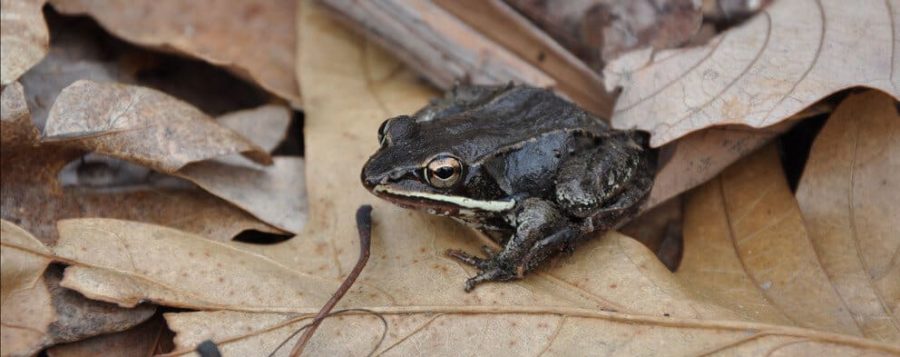Frogs from noisy ponds near highways have altered stress and immune profiles compared to frogs from more quiet ponds — changes that reduce the negative effects of traffic noise on the amphibians. According to a new study, when frogs from quiet ponds are experimentally exposed to traffic noise, the noise is stressful and impairs the production of antimicrobial peptides — an important defense mechanism against pathogens. However, frogs taken from ponds near highways show a dampened stress response and altered immune profile, both of which reduce the costs of traffic noise. The study appears online Nov 21, in the journal Proceedings of the Royal Society B.
“In the United States, traffic noise can be heard nearly everywhere,” said Jennifer Tennessen, first author of the paper, who was a graduate student at Penn State at the time of the research and is currently a research associate at Western Washington University. “Noise can have a number of negative consequences on wildlife, for example by interfering with communication and reducing the ability to find food. Frogs are particularly vulnerable to noise because they rely on sound to find mates and reproduce. Wood frogs travel to ponds in the spring to mate and lay their eggs, but many of these ponds are located near noisy roads. We wanted to know if traffic noise has negative physiological effects on wood frogs and, if so, whether they can adapt.”
The researchers collected eggs from ponds located less than 300 feet from interstates and major highways and from ponds in more isolated settings, up to 3 miles from major roads. The eggs were raised through metamorphosis in the lab, and the resulting frogs were exposed either to traffic noise or to ambient noise similar to that at the quiet ponds for 8 days, about the length of time they would spend at breeding ponds.
The researchers found that frogs from the quiet ponds had increased levels of the stress hormone corticosterone after exposure to traffic noise for 8 days, indicating that the noise is stressful. Noise exposure also affected immune function in frogs from quiet sites, increasing counts of a type of white blood cell called monocytes — an indication of an immune response to noise — and impairing the production of important compounds on the skin called antimicrobial peptides.
“In frogs from quiet ponds, exposure to traffic noise impaired the ability to produce antimicrobial peptides in the brevinin and temporin families,” said Louise Rollins-Smith, professor of pathology, microbiology and immunology at the Vanderbilt University School of Medicine and an author of the paper. “Antimicrobial peptides are components of the immune defense system that provide important protection against pathogens like bacteria and fungi. Brevinin-family peptides in particular strongly inhibit the fungal pathogen that causes the infectious disease chytridiomycosis, or chytrid, which is responsible for widespread mortality of amphibians around the world.”
The researchers also investigated whether frogs have developed ways to deal with these negative consequences of traffic noise.
“Long-term elevation of stress hormones can lead to negative immune consequences,” said Tracy Langkilde, professor and head of biology at Penn State and senior author of the paper. “So we might expect to see suppression of the stress response after long-term stress exposure to reduce immune costs, such as the altered production of skin peptides that we documented here. In frogs from noisy ponds, we see just that.”
Frogs from noisy ponds did not have elevated levels of corticosterone after exposure to traffic noise for 8 days, suggesting that frogs from ponds in high-noise areas have a suppressed stress response.
“We’re not sure if the frogs from noisy sites have a suppressed stress response to noise specifically or if they have a suppressed stress response overall,” said Langkilde. “Both offer the benefit of avoiding stress-related costs of noise, but having a dampened stress response in general could have other negative effects, for example not being able to properly mount a behavioral response to predators.”
Unlike frogs from quiet ponds, which had increased monocyte counts when exposed to traffic noise, frogs from noisy ponds actually had increased monocyte counts when exposed to the ambient noise heard at quiet ponds. The researchers believe that this kind of immune response may happen in unfamiliar situations, and supports the idea that frogs from noisy sites have adapted to avoid the physiological costs of noise.
“In the future, we hope to pinpoint the mechanism of how frogs are adapting to noise,” said Tennessen. “The roads near the ponds we studied were built between the 1940s and 1960s, so these changes may have occurred within 15 to 35 frog generations. People usually think of adaptation and evolution occurring over huge timescales, but here we see that animals can respond relatively quickly to new threats, though the consequences of that response are still unclear.”
In addition to Tennessen, Rollins-Smith and Langkilde, the research team includes Susan Parks at Syracuse University; Lindsey Swierk, graduate student at Penn State at the time of the study and currently at Binghamton University; Laura Reinert at Vanderbilt University School of Medicine; Whitney Holden, graduate student at Vanderbilt University School of Medicine at the time of the study and now at the Arkansas School for Mathematics, Sciences and the Arts; and Koranda Walsh at the University of Pennsylvania School of Veterinary Medicine.
This work was funded in part by Penn State, the Penn State Applied Research Laboratory, Sigma Xi, the American Society for Ichthyology and Herpetology, and the National Science Foundation. Additional support was provided by the Huck Institutes of the Life Sciences at Penn State.



